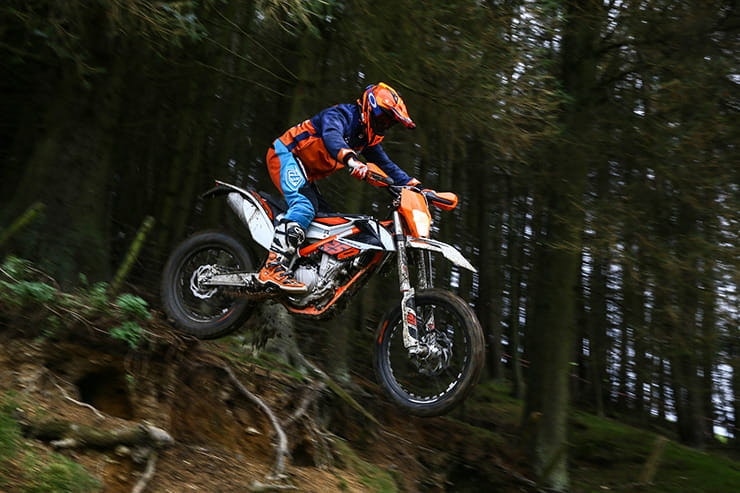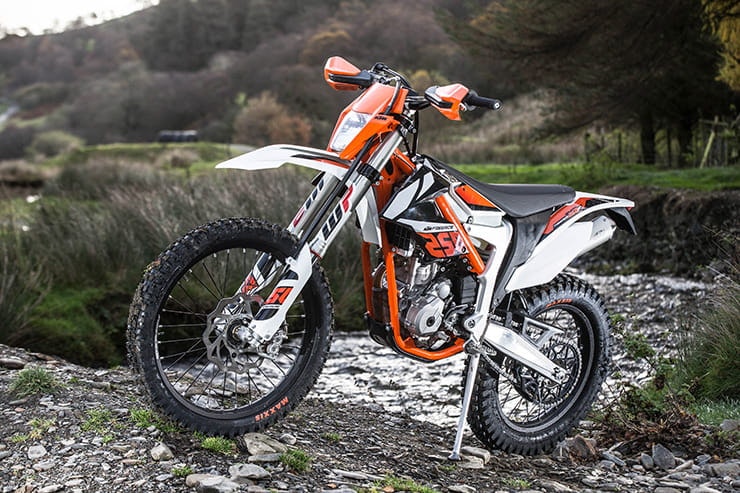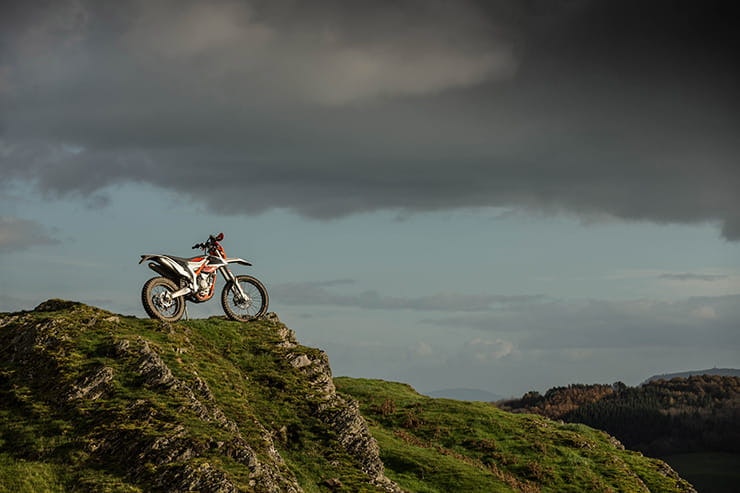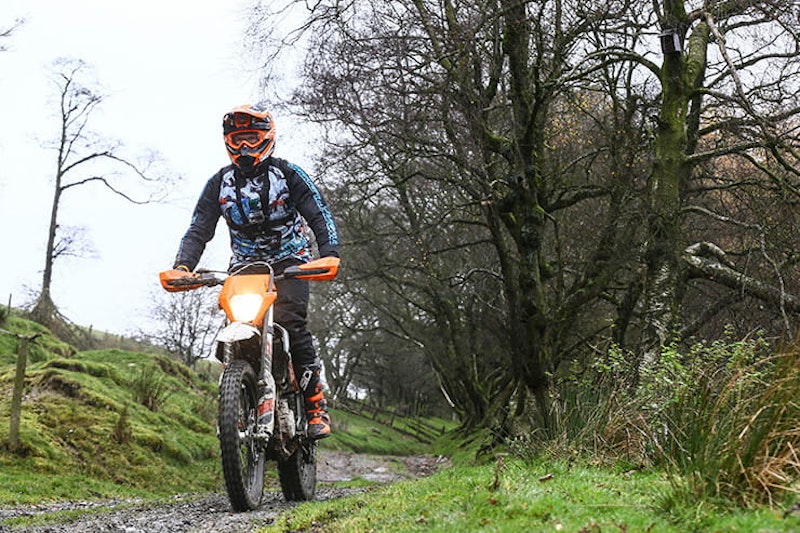KTM Freeride 250 F (2018) - First Ride and Review
By Kane Dalton
BikeSocial's former Commercial Manager
16.11.2017
KTM’s resurgence has seen the firm continuing to grow globally…annual sales are up by more than 10% and the manufacturer is now expanding production. In fact, the popularity of the orange stand at the Milan Motorcycle Show last week underlines both their appeal and growth.
So what is new for 2018? Well, the 790 DUKE in its prototype form has been grabbing some headlines for the past 12 months and will earn plenty more now it’s been revealed in production form but if you prefer playing in the mud and dirt, then there is something new for you too…
If you’re a pro rider you’ll be looking at the new competition 2-stroke bikes but if you’re like me and looking for an easy-to-ride off-road bike, then the new Freeride 250F with KTM’s new single cylinder, 4-stroke may be for you. And at just £6599 looks like decent value on paper.
Because the bike is lightweight, agile and 4-stroke it’s therefore easier to ride than the more aggressive 2-stoke bikes meaning the target audience for KTM are those who are new to off-roading or those who are looking for a giggle or even trials riders (as a crossover bike).
Therefore, the Freeride is right up my street. I did a bit of off-roading as a kid back in South Africa on bikes like the RM80 but then mostly road riding from my teens. Though I did a couple of experience off-road days in 2016 with Mick Extance, firstly when he was with Kawasaki and then again when he changed to being a Honda school. So yeah, I have a little experience.
The Bike
KTM’s FREERIDE range was launched in 2012 and this new bike replaces the 4-stroke FREERIDE 350 and the 2-stroke FREERIDE 250 R, with ‘Freeride’ referring to “off-road fun without pressure!”, so say KTM.
So, when I got the invitation to the launch at the Berwyn Leisure (Llanarmon) venue of the KTM Enduro Experience in Wales, the first thing I did was look for YouTube footage to see the type of terrain and surroundings and therefore what I’d let myself in for.
On the e-mail confirmation addressed to all invitees, I noticed the names of the riders that had been invited to the launch. One name jumped out at me; Dave Willet, a former British motocross champion who has been intentionally kicking mud in my face for some time. When we worked together previously I looked after road bikes and Dave was the off-road wizard, one day I convinced Dave to ride road bikes with me at Donington having never ridden a road bike on track before. So the time had come for his payback – especially after I’d promised I would ride off road with him at some point but I never thought I would actually have to fulfil the promise. No pressure!
First impressions
The bike looks like an enduro crossed with a trials machine with the geometry certainly more trials-ey and it’s this influence that’s easy to spot in its flat profile. Some of the skilled trails guys tested its capability by taking the bikes over the trails course where the large tractor tyres that had been set upright weren’t much of an obstacle.
At first glance the bike looks appealing, though I wonder where the fuel tank is and therefore what I am going to grip with my knees. Turns out it’s hidden under the seat giving the bike that flat profile and allows you move around more freely, getting right over the front wheel when you want to in corners.
The long, narrow seat offers unrestricted movement and, even through my padded shorts, felt firm. I spent very little time sitting though, most of the riding was more appropriate to be stood on the pegs. The rare occasions where I needed the seat was for a little extra rear grip and when stationary to take in the epic Welsh scenery.
The seat lifts to allow easy access to the transparent 5 litre tank, fuel filter and electrics that are well protected between the upper frame rails and as soon as I swung my leg over I was struck by how compact, narrow and light it is. Lifting the bike off the stand was effortless.
I’m over 6ft so don’t mind a tall seat on a bike. The Freeride 250 F has plenty of ground clearance but the seat is a bit lower than other bikes in the class. It is a shade over 900mm but there is an optional kit that can lower it by 25mm. Of course, it’s not a bother when you spend so much time on the pegs!
Speaking of which, the foot pegs are adjustable. I spent the day in the forward position but by reversing the footpeg brackets, the position can be moved 8 mm back. This lets you fine-tune the traction and cornering behaviour of the bike: the front position means easier cornering, while the rear position yields increased traction. And of course for your comfort.
It’s good to see that open hand guards are now standard offering protection from stones, branches other bikes and rocks when you fall off. These often come as optional add-on. There’s also front light for road and night use, and handy for night enduro races, if you’re that way inclined.
The handlebars are tapered and slightly wider than the old model to offer more turn leverage. They’ve also been fitted with a vulcanized grip on the throttle assembly and an ODI lock-on grip on the left side bar. The throttle assembly has an aluminium body with easy free play adjustment.
The layout is almost mountain bike like, its minimal, you only get what you need, all adding to the weight saving.
The multifunction digital dashboard has integrated warning and indicator lights and shows speed as well as hours of engine use and the back-lit display is a doddle to see on the move if you really need to take your eyes off the next jump, deep water or mud.
For everyday riding there’s a key and an ignition lock which is a nice security feature. The key is tucked away on the right with the handlebars giving the key some protection.
Riding impressions
It had been raining the day before so the conditions at the start of the day were wet and muddy. There was even a little light rain during the day but hey, it’s Wales in November, I wasn’t expecting stunning weather. We started our day riding the moto X track as a decent warm up, getting used to the deep rutted mud, puddles and some more compact sections. The trial tyres were a bit limiting through the deeper mud but it didn’t stop the advanced boys from getting some big air or for giving us all a demonstration on how to ride up a sheer rock face. The sort of thing you would not try and climb on foot.
I’m an experienced road rider, one that is ok with getting caught out in the rain but wouldn’t necessarily set off in the rain. (I have had some big offs on the race track in the wet) yet for some reason as soon as I got on the KTM, all I wanted to do was ride through every puddle was determined to get some air on the jumps.
Traction and power delivery is so easy on the bike. Once you start to find the sweet spot with your weight on the pegs it just floats.
When you open the throttle the power delivery is smooth and linear. You can open the throttle with confidence and don’t need to concentrate too hard on being a hooligan.
We explored other wet surfaces and rode through mud and rock gullies, real deep mud, up steep hills and down some that even steeper. The Freeride made short work of everything thrown at it. Riding on wet grass fills me with dread and while I can bask in a little glory having not fallen off on the grass, that was short-lived as I did manage to fall off elsewhere, all due to pilot error.
The bikes had arrived relatively fresh from the European launch so the tyres had already seen some action. Traversing the edge of high hills on the wet grass made me nervous as the trials tyres clogged up quickly, they don’t have the same edge grip of an enduro tyre. Despite the challenge none of the riders had an issue on the grass. A credit to the lightweight agility of the bike and at less than 99 kg it is an easy to manage and turn.
It is also easy to pick up when you have fallen off or to pull out of a deep hole in the ground! We had been warned that they were a few deep holes in the long grass, the farmers had lost sheep to some. I found one. The bike dropped in and was suspended by the handle bars. The very same bars I flew over but thankfully it was a Freeride 250 F and not a SuperAdventure 1290 S so I was able to pull the bike out the hole on my own and continue, a little red-faced.
The suspension gives you uber confidence, and you feel as stable as you can feel riding in the dirt. The new bike uses the new 43 mm Xplor upside-down fork by WP Suspension with 250 mm of travel. A split design – both of its legs contain springs but separate the damping functions. Rebound is in the right leg, compression on the left, so they can function without interfering with each other and are adjustable from on top of the fork legs.
The new PDS rear suspension works in tandem with the 260 mm of wheel travel and comes complete with a shock absorber mounted directly to the swingarm. Compression and rebound damping are adjustable and separate high and low-speed compression adjustments are provided.
The bike felt stable under braking and it was easy to hold a line in the corners. Over smaller bumps it felt like the bike was tracking smoothly and the suspension was doing a great job.
The last time took a jump on an enduro it bottomed out. Probably a combination of the soft set up and my slam dunk landing. This time the landing was better, the upgrade makes stiffer and more stable on the landing.
The CNC-machined triple clamp offers a degree of rigidity plus better control and tracking of the front wheel.
The backbone of the bike is the new frame; it follows the previous lightweight composite designs and geometry. The rigid frame in theory reduces vibration and increases cornering precision which was true enough because I wasn’t aware of any heavy vibration.
The steep steering head angle and short wheelbase helps in tough terrain by allowing you to get over the front wheel more when needed and the short wheelbase makes for quicker turning. A few times in the deep grass I only saw obstacles as I hit them and I was able to all of them that were not a 6ft ditch with ease.
A longer steering head is rigid which gives you better tracking stability. Further weight savings are made with the polymer subframe and cast – aluminium swingarm that is only 3.2kg
I was pleased that the bikes are fitted with an electric start too. It makes life so much easier. In the old days you would lose the skin off your shins trying to kick start a bike. You could easily break a bone when the high compression kicked back. It becomes a bigger challenge when you have fallen off or stalled in a tricky place like a steep incline, water or mud. It is really hard to keep your balance, hold the bike and kick.
The new engine is compact and being a 250cc DOHC 4-stroke engine, is more reliable than a two stroke. The engine is based their competition Enduro KTM 250 EXC-F.
The standard bike is restricted produces 20.5 bhp, the bikes we tested were derestricted with 26 bhp. The engine is makes its power low down and develops in a smooth linear way to the top end of the rev range. This means that there are no surprises is the power band, it’s just smooth delivery all through.
There is enough torque to roll on in lower gears without having to change down. You need to change gear more often than you would with a 450 but this makes the experience more engaging. I spent most of the time riding in second gear which is effortless to get up to 45 mph.
The connection between the throttle and engine the is good and predictable. The tractable power delivery and smooth engine characteristics extend an open invitation to everybody. I almost feel like I need to ride again tomorrow and give the throttle more beans.
The 6-speed transmission is operated via a ‘No Dirt’ gear shift lever that prevents dirt from blocking the joint. Most of the dirt was on me! The gear changes both up and down the box feels smooth and I was even able to make clutchless changes in both directions which is useful on steep declines where the back wheel was starting to lock up, hooking up another gear fixed that.
The 4-stroke is 20 mm shorter than its predecessor, weighs 1.5 kg less at 27.6 kg and is mounted directly into the centre of the bike. More centralised mass help the handling.
Unlike road riding you tend to favour the rear brake off road, using too much front makes the bike dig in. Or it makes you fall off. Both aren’t that pleasant. Riding down a hill over wet rock I took a handful of front brake and then a mouthful of mud. If you are going to do something stupid, do it where the photographer is standing!
On the steep downhill sections both brakes were effective, predictable and easy to use. There are radial 4-piston calipers up front and a radial 2-piston caliper in the rear, with 260 and 210 mm Wave brake discs.
The braided front brake hose routes the speedometer cable through an integrated channel for extra protection.
Thankfully, the best combination for stability and corner grip is to run an MX or enduro tyre and a wheel combination of 21” front and 18” rear which is exactly what the KTM has.
The Maxxis Trialmaxx OEM tyres were developed specifically for the KTM FREERIDE range. KTM say they are kinder to the terrain and leave less footprint. They offer less performance than competition tyres which is acceptable for a beginner but I would upgrade.
With increased campaigning against noise levels, KTM have reduced the sound output by focussing on low noise levels and emissions as well as good torque delivery. The exhaust system is well protected by a bash plate and is euro compliant with catalytic converters. There is always a compromise on power when you limit output, the 26 bhp was more than enough for me and they have created goodwill with a smaller environmental footprint.
Build quality
This may be a bike aimed at new or returning riders yet it is going to capture the attention from trails riders too. The build quality is often cheap when chasing this market but the KTM is built to high standards. Also after falling off, riding through rough terrain and water, nothing leaked, or fell off and it started on the button each time.
At the end of the day when the bikes were jet washed the bikes, its plastics, castings and decals looked brand new again.
Conclusion
This bike is great fun to hurtle up and down the trails and really is dead easy to ride. As the day progressed I was feeling far more confident and the grin factor was exponential.
The 250F makes a great alternative for experienced trails riders looking for a vehicle for longer trail rides and Enduro riding with a more comfortable seat and larger fuel tank than a genuine Trials motorcycle offers.
It is an excellent climber for adventurous riders looking to explore new limits yet is also a controllable introduction to off-road riding.
I’ve been looking for a beach race / flat-tracker and I reckon the KTM would fulfil this as well as being a bike I could take out on the green lanes. I need to make that call to the bank manager and arrange the finance, then find a friend that is willing to hide the bike away for me though because I have been told by the missus that my formula of plus one for bikes has a fatal flaw, I fear when she says fatal she is referring to me.
TECHNICAL FACTS
New: ultra-compact 4-stroke engine with 6 speed transmission and torque-oriented performance characteristics
New: hydraulic DS clutch with wear-free steel basket and diaphragm spring
New: compound frame made from chrome-molybdenum steel and forged aluminium with bolt-on polymer rear subframe
New: adjustable WP Suspension XPlor 43 fork with 250 mm of travel and new CNC machined triple clamps
New: WP Suspension rear suspension with new WP XPlor shock absorber featuring multiple adjustments, 260 mm of wheel travel
New: Extremely low weight of only 98.5 kg
Adjustable footpegs with eccentric mounts
Maxxis Trialmaxx tires – specially developed for the KTM FREERIDE series
E-starter and lightweight lithium-ion battery
TECHNICAL SPECIFICATION
Share on social media:



